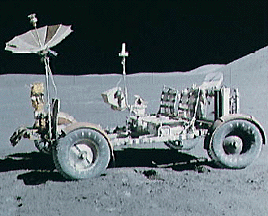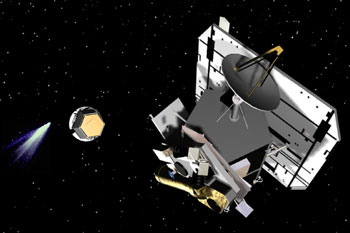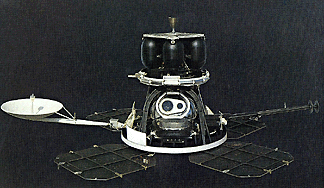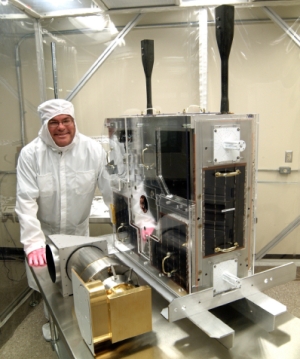The tiny MOST satellite with mission scientist Jaymie Matthews.
Click on image for full size
Canadian Space Agency
Related links:
MOST website
MOST - Canada's first space telescope
The MOST (Micro-variability and Oscillations in STars) satellite is
Canada's first space telescope. It is about the same size as a large
suitcase. It was
launched into orbit from Russia in June 2003 using
a missile that was originally built for a nuclear warhead. Under an
international peace treaty the missile was required to be destroyed
anyway, so they decided to use it for science!
Inside MOST, there is a 6-inch diameter reflecting telescope and a
high quality digital camera. Scientists use the camera to take a
series of images of pulsating stars, and record the amount of light
reaching us over time. They use this information to learn about
the insides of the stars, with a technique called astero-seismology.
The scientists communicate with MOST and receive data through a few
small radio dishes located in Toronto, Vancouver, and Vienna. Since
it is tiny compared to the Hubble Space Telescope, MOST has earned
its nickname: the "humble space telescope". It may be small, but it
has already made some big discoveries! Visit the MOST website for
details.
You might also be interested in:

The Hubble Space Telescope (HST) was one of the most important exploration tools of the past two decades, and will continue to serve as a great resource well into the new millennium. The HST is credited
...more
Driven by a recent surge in space research, the Apollo program hoped to add to the accomplishments of the Lunar Orbiter and Surveyor missions of the late 1960's. Apollo 11 was the first mission to succeed
...more
Apollo 12 survived a lightning strike during its launch on Nov. 14, 1969, and arrived at the Moon three days later. Astronauts Charles Conrad and Alan Bean descended to the surface, while Richard Gordon
...more
Apollo 15 marked the start of a new series of missions from the Apollo space program, each capable of exploring more lunar terrain than ever before. Launched on July 26, 1971, Apollo 15 reached the Moon
...more
NASA chose Deep Impact to be part of a special series called the Discovery Program on July 7, 1999. In May 2001, Deep Impact was given the "go" from NASA to start with mission development. Deep Impact
...more
The Galileo spacecraft was launched on October 19, 1989. Galileo had two parts: an orbiter and a descent probe that parachuted into Jupiter's atmosphere. Galileo's primary mission was to explore the Jovian
...more
During 1966 through 1967, five identical Lunar Orbiter spacecrafts were launched, with the purpose of mapping the Moon's surface and finding smooth, level terrain, in preparation for the Apollo and Surveyor
...more















